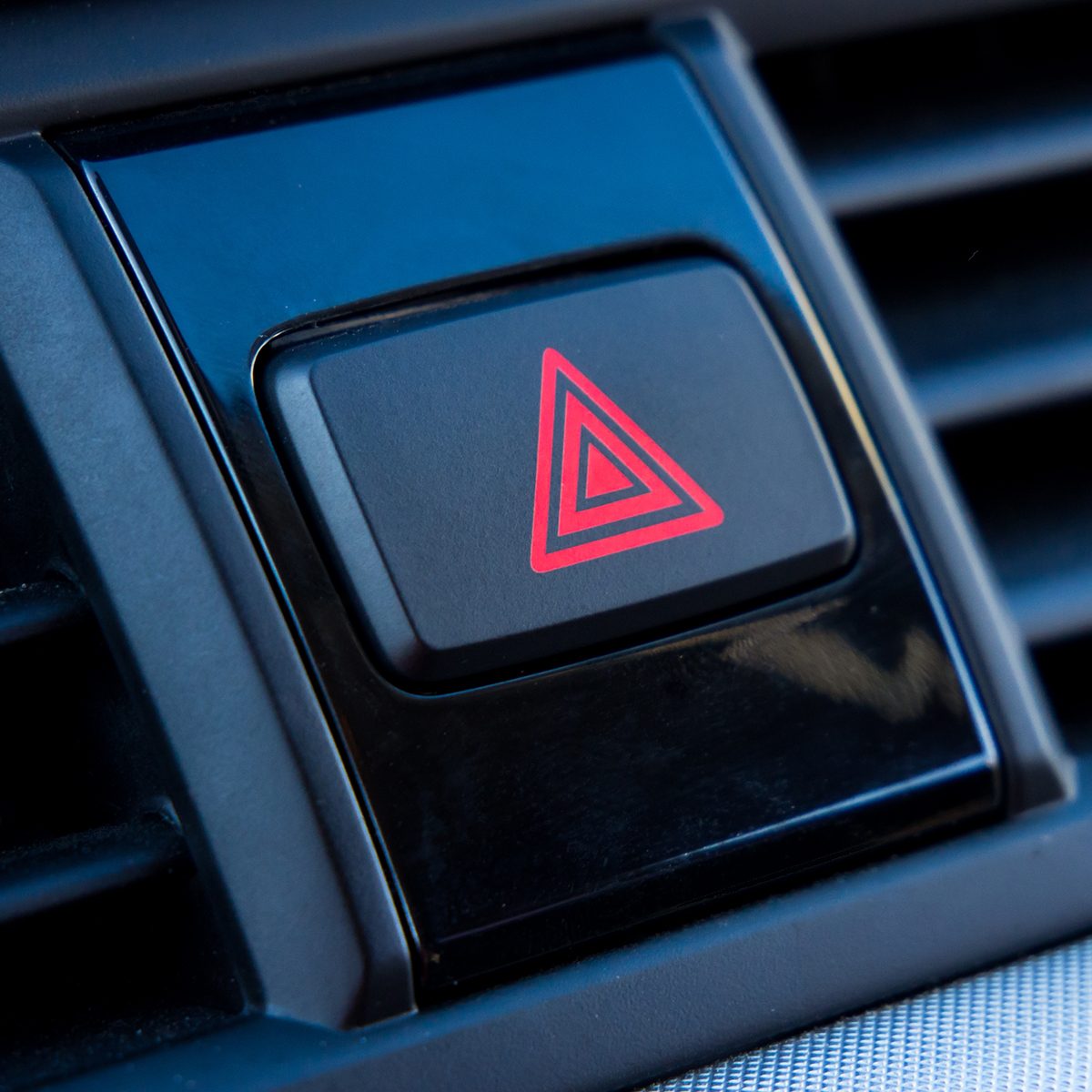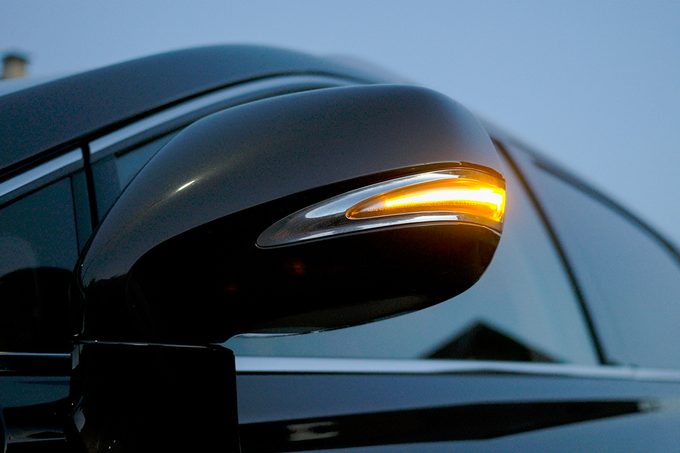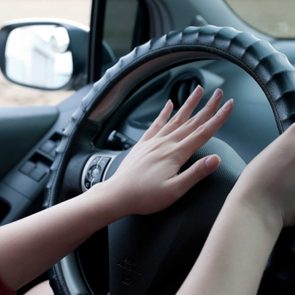The rules vary state by state, so make sure you know the guidelines before you buckle up and drive

These Are the Only Times You Should Use Your Hazard Lights

You’re behind the wheel when suddenly sheets of rain begin to pour down and visibility drastically drops, turning your road trip, commute or errand-running into a hazardous situation. Through the downpour on your windshield, you’re barely able to see that drivers in front of you are turning on their car hazard lights, but should you do the same?
“In some states, driving with your hazards on can get you in trouble,” says ASE-Certified technician Frank Leutz, owner and COO of Desert Car Care Center of Cave Creek in Arizona. “You might even face a reckless driving charge.”
Read on to learn when to use hazard lights. Plus, before you hit the road, brush up on these weird car features you probably didn’t even know you have.
What are hazard lights?
Technically speaking, there are no such things as hazard lamps on a vehicle, shares Kent Agne, manager, lamp design regulation and standards at Nissan. “It’s a common misconception, and many state and local laws refer to this term. However, a ‘hazard warning signal’ control switch, marked by a symbol with two triangles, can be found on every vehicle.
The purpose of hazard lamps, as stated in Federal Motor Vehicle Safety Standards (FMVSS) No. 108, is “to indicate to approaching drivers the presence of a vehicular hazard.” And “Just as seeing a turn signal on the left side of a vehicle makes an observer think ‘that car is going to be turning left soon,’ seeing all the turn signals flashing together makes people realize that something isn’t quite right (and hopefully makes them proceed with extra caution), explains Agne.
When should you use hazard lights?
Hazard lights are meant to alert other drivers of a potential hazard ahead. But knowing when to use hazard lights can be the difference between safely alerting others and causing a bigger issue. Here are some situations where you should use your hazard lights.
You’re getting pulled over by a police officer
Seeing those red and blue lights flashing in your rear-view mirror? Flip on your hazard lights as you’re pulling over. “Using your hazard light when getting pulled over is a good common sense practice,” says says automotive educator Chaya M. Milchtein, author of Mechanic Shop Femme’s Guide to Car Ownership. “It shows the officer that you’re aware that you’re getting pulled over and complying, perhaps just looking for a safe place to do so.”
You get into a car accident
“If you are involved in a car accident, turning on your hazard lights helps alert drivers to slow down and go around you, preventing another accident,” says Milchtein. “It can also assist emergency responders in locating you, partially after dark or in busy areas.” Here are other important things to do after a car accident.
Your car breaks down
Having car trouble? Milchtein says if your car breaks down in an unsafe or highly trafficked location, turning on your hazards will alert drivers to your vehicle. Ideally, this will help avoid a secondary accident.
You’re changing a tire
“When pulling over your vehicle due to an emergency break down, particularly if you’ll be getting out of your vehicle, it is critical to use your hazards to warn other drivers,” says Milchtein. “This allows them advance notice of your stopped vehicle so they can slow down or move over.” If you need to change a tire on the side of the road when it’s dark or foggy, hazard lights can be a lifesaver.
You’re driving in a funeral procession
In many areas, Milchtein says it’s traditional to use your hazards when you’re part of a funeral procession. “It shows the other drivers on the road that you’re part of the procession and advises them to yield according to local traffic rules,” she says.
You see a sudden slowdown or accident on the highway
If you’re driving down the highway and suddenly a car loses control ahead of you or you find yourself in an unexpected slowdown, Milchtein says using your hazards could help alert drivers behind you of the slowdown ahead. This should only be done in states where driving with your hazards on is allowable by law (more on that shortly).
When should you not use hazard lights?

There are certain situations where you shouldn’t use your hazard lights (even if you see others using them). Think twice before using them in these situations.
Illegal parking
Need to run into the store real quick? Park your car in a designated space—don’t park illegally and flip on your hazard lights to signal you’ll be back shortly. “Being double-parked or stopped in a no-parking zone can result in a ticket violation,” says Leutz. “Hazard lights are a beacon to attract police officers.”
Driving in bad weather
Bad weather isn’t an excuse to use your hazard lights. “Hazard flashers can do more harm than good when you’re driving in bad weather conditions,” warns Leutz. “Because both signal lights are blinking at the same time, other drivers won’t be able to tell which lane you’re about to go to.” Here are a few more safe driving tips for scary driving situations.
Slowing down to exit the highway
If you’re having car trouble and need to exit the highway, it’s best to reconsider using your hazard lights as you’re exiting. “You can not use your turn signals and hazards simultaneously,” says Milchtein. “If exiting the highway, rather than pulling over, avoid using the hazards and instead indicate that you’re exiting. Turn the hazards on once off the highway and safely pulled over.”
How to turn on hazard lights
Look for a red triangle on your dashboard, steering column, or center console, and press it to turn on the hazards. “This will cause all of your turn signals to flash simultaneously,” says Milchtein. “To turn the hazards off, press the button with the red triangle a second time.” While this is typical of most, if not all, vehicles, it’s worth figuring out where the hazard lights button is before driving if you’re in a new or rented vehicle (the same advice holds true for determining which side of the car your gas tank is on).
It’s important to note that hazard lights are powered by your car’s battery, which means they can drain the battery if used for too long. “There are many factors that contribute to the amount of time before your battery dies,” notes Leutz. “It’s a good idea to only use your hazard lights for one to two hours.”
Hazard light laws in each state
One of the most important things to remember about hazard light laws is that they differ from state to state. Here’s a breakdown of hazard light use in each state, according to AAA.
States where you can use your hazard lights while driving unless otherwise noted
Alabama, Connecticut, Georgia, Kentucky, Michigan, Mississippi, Missouri, Nebraska, New Hampshire, New Jersey, New York, North Carolina, North Dakota, Oregon, Pennsylvania, South Dakota, Texas, Utah, Vermont, and Wyoming.
States where you can’t use your hazard lights while driving except in an emergency or in other specific instances
Arizona, Arkansas, California, Colorado, Delaware, Idaho, Indiana, Iowa, Maine, Maryland, Minnesota, Montana, Ohio, Oklahoma, South Carolina, Tennessee, Virginia, Washington, West Virginia, and Wisconsin.
States where you can’t use your hazard lights while driving
Alaska, Florida, Hawaii, Illinois, Kansas, Louisiana, Massachusetts, Nevada, New Mexico, and Rhode Island. Clark reminds us that the misuse of hazard lights can lead to legal consequences, including a traffic ticket. Keep these hazard light laws in mind, especially if you’re taking a road trip anytime soon.
Do these three things before hitting the road
Now that you know more about when to use hazard lights, here’s what you can do to reduce the chances of having to use them on the road.
-
Be aware of the weather and road conditions: Even if you and your car are fully prepared to handle anything the road throws at you, understanding what you’re driving into is critical for being prepared. “If snow is expected, perhaps fill up your tank before getting too far into your trip, just in case,” says Milchtein. “It also allows you to double-check your emergency kit or reconsider the drive if the weather is worse than expected.”
-
Inspect your car: New CARFAX data shows 29% of Americans are behind on oil changes and 44% haven’t had their tires rotated as required. Regularly check over your vehicle, practicing preventive maintenance like checking and adjusting your tire pressure, oil levels, wiper blade fluid, and more. Milchtein says this will help your car be prepared for the road and minimize the chances of unexpected failures due to low tire pressure, oil leaks, and so forth. Here are some important car maintenance tips to keep your vehicle running smoothly.
- Be prepared—It’s better to be safe than sorry when driving. Be prepared while on the road with these items you should always keep in your car, including The Antigravity Batteries XP-10 battery charger, which Consumer Reports also recommends.
Now, don’t miss these car hacks that will make driving even safer.
About the experts
|
Why trust us
At Reader’s Digest, we’re committed to producing high-quality content by writers with expertise and experience in their field in consultation with relevant, qualified experts. We rely on reputable primary sources, including government and professional organizations and academic institutions as well as our writers’ personal experiences where appropriate. Our writers ensure that all information is accurate and offers the best possible advice to readers. Read more about our team, our contributors and our editorial policies.
Sources:
- Frank Leutz, ASE-Certified technician, owner and COO of Desert Car Care Center of Cave Creek
- Kent Agne, manager, lamp design regulation and standards at Nissan
- Federal Motor Vehicle Safety Standard 108 definition
- National Highway Traffic Safety Administration: “16-1289 (GM hazard innovative) — 28 Apr 16 rsy”
- CARFAX Data: It’s Scary How Many Americans Are Behind On Car Maintenance
- Consumer Reports: “Jump Starter Buying Guide”
- Chaya M. Milchtein, author of Mechanic Shop Femme’s Guide to Car Ownership





















